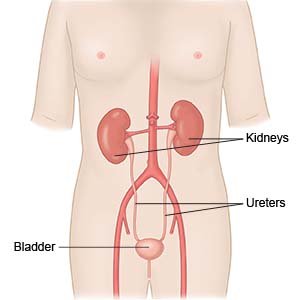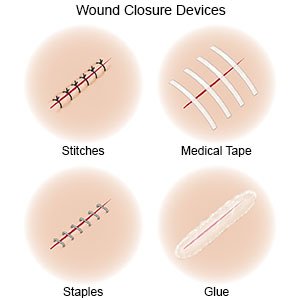Robot Assisted Nephrectomy
Medically reviewed by Drugs.com. Last updated on Aug 4, 2025.
AMBULATORY CARE:
Robot-assisted nephrectomy (RAN)
is surgery to remove part or all of your kidney through small incisions in your abdomen. RAN is done with a machine that is controlled by your surgeon. The machine has mechanical arms that use small tools to remove your kidney.
 |
How to prepare for RAN:
- Your surgeon will tell you how to prepare. You may be told not to eat or drink after midnight on the day of your surgery. Arrange to have someone drive you home after you are discharged.
- Tell your surgeon about all your current medicines. Your surgeon will tell you if you need to start or stop taking any medicine for the surgery, and when to do so.
- Tell your surgeon about any allergies you have, including to medicines, anesthesia, stainless steel, nickel, or titanium.
- Your surgeon will tell you if you need tests before your surgery, and when to have them.
What will happen during RAN:
You may have a radical (total) or partial nephrectomy. For a radical nephrectomy, your surgeon will remove the whole kidney. Your surgeon may also remove the ureter (tube that connects the kidney and the bladder), the adrenal gland, or lymph nodes. The adrenal gland sits on top of your kidney and produces hormones. For a partial nephrectomy, your surgeon will remove only the diseased parts of the kidney.
- You will be given general anesthesia to keep you asleep and pain free during surgery.
- Your surgeon will make 3 to 5 small incisions in your abdomen. Your abdomen will be filled with carbon dioxide to lift the muscles away from your organs. This helps your surgeon see your kidney better. Surgical tools are attached to arms of a robot. The robotic arms place a laparoscope and other tools inside your abdomen. A laparoscope is a long, thin tube with a light and camera on the end.
- Your surgeon will guide the robotic arms to remove the kidney through an incision in your abdomen.
- Your incisions will be closed with stitches or medical glue and covered with bandages.

What to expect after RAN:
- You will be taken to a room to rest until you are fully awake. Healthcare providers will monitor you closely for any problems. Do not get out of bed until healthcare providers say it is okay. When providers see that you are okay, you will be taken to your hospital room. You may stay in the hospital for 2 to 3 days after surgery.
- Drains (thin rubber tubes) may be used to drain fluid from around your incision. The drains will be taken out when the surgery area stops draining.
- You may have a urinary catheter placed in your bladder. This is a thin, flexible tube inserted into the bladder to drain urine into a bag. Your surgeon will tell you when the catheter can be removed.
- You may feel pain around the incision sites. This is expected and should improve within a few weeks. You may be given medicine to help manage the pain.
- You will be helped to walk around after surgery. Movement will help prevent blood clots.
Risks of RAN:
You may get an infection or bleed more than expected. Your surgeon may need to change the surgery from laparoscopic to open. This means you will need 1 large incision. Nerves, blood vessels, muscles, or organs may be damaged. Urine may leak into surrounding tissues. This may occur if the urinary tract is damaged during surgery or the incision does not heal properly. The carbon dioxide used during surgery may cause shoulder or chest pain for 1 to 2 days after your surgery. Your other kidney may not work as well as it did before.
Related medications
Call your local emergency number (911 in the US) for any of the following:
- You have sudden chest pain or trouble breathing.
Seek care immediately if:
- Blood soaks through your bandage.
- You have blood in your urine.
- You urinate small amounts or not at all.
- Your stitches come apart.
- You have fluid buildup in your legs.
- Your surgery area is red, swollen, or draining pus.
Call your surgeon or urologist if:
- You have a fever.
- You have severe abdominal or low back pain.
- You have chills, a cough, or feel weak and achy.
- You have questions or concerns about your condition or care.
Medicines:
You may need any of the following:
- Prescription pain medicine may be given. Ask your healthcare provider how to take this medicine safely. Some prescription pain medicines contain acetaminophen. Do not take other medicines that contain acetaminophen without talking to your healthcare provider. Too much acetaminophen may cause liver damage. Prescription pain medicine may cause constipation. Ask your healthcare provider how to prevent or treat constipation.
- Acetaminophen decreases pain and fever. It is available without a doctor's order. Ask how much to take and how often to take it. Follow directions. Read the labels of all other medicines you are using to see if they also contain acetaminophen, or ask your doctor or pharmacist. Acetaminophen can cause liver damage if not taken correctly.
- Antibiotics may be given to prevent or treat a bacterial infection.
- Bowel movement softeners may be given to help prevent constipation.
- Take your medicine as directed. Contact your healthcare provider if you think your medicine is not helping or if you have side effects. Tell your provider if you are allergic to any medicine. Keep a list of the medicines, vitamins, and herbs you take. Include the amounts, and when and why you take them. Bring the list or the pill bottles to follow-up visits. Carry your medicine list with you in case of an emergency.
Self-care:
- Care for your incision sites. Ask when you can remove your bandages. Gently clean the sites with soap and water. Do not rub the sites. Do not take a bath, swim, or get in a hot tub until your healthcare provider says these are okay. Keep the areas clean and dry. Gently pat the areas dry and put on new, clean bandages, if directed. Check for signs of infection, such as redness, swelling, or pus.
- Ask when it is okay to return to your usual daily activities. You may need to wait 4 to 6 weeks after surgery. Slowly start to do more each day. Your provider will tell you about the activities you should avoid after your surgery. You may also be given a weight restriction on lifting objects.
- Drink liquids as directed. Liquids will help prevent constipation and help your other kidney work correctly. Keep track of how much liquids you drink and how often you urinate. This helps you stay hydrated and prevents too much water loss. Follow your provider's instructions about how much liquid to have each day and which liquids are best for you.
- Choose a variety of healthy foods. Healthy foods include fruits, vegetables, whole-grain breads, low-fat dairy products, lean meats, and fish. Your provider or dietitian may recommend that you limit protein foods such as milk, fish, and meat. Protein will make your kidney work harder.

- Limit or do not drink alcohol or caffeine. Alcohol and caffeine can cause strain on your other kidney and increase your risk for dehydration.
- Do not smoke. Nicotine and other chemicals in cigarettes and cigars can delay healing. Smoking also increases your risk for infection after surgery. Ask your provider for information if you currently smoke and need help to quit. E-cigarettes or smokeless tobacco still contain nicotine. Talk to your provider before you use these products.
Follow up with your surgeon or urologist as directed:
You may need to return to have your wounds checked and stitches removed. Write down your questions so you remember to ask them during your visits.
© Copyright Merative 2025 Information is for End User's use only and may not be sold, redistributed or otherwise used for commercial purposes.
The above information is an educational aid only. It is not intended as medical advice for individual conditions or treatments. Talk to your doctor, nurse or pharmacist before following any medical regimen to see if it is safe and effective for you.
Further information
Always consult your healthcare provider to ensure the information displayed on this page applies to your personal circumstances.
